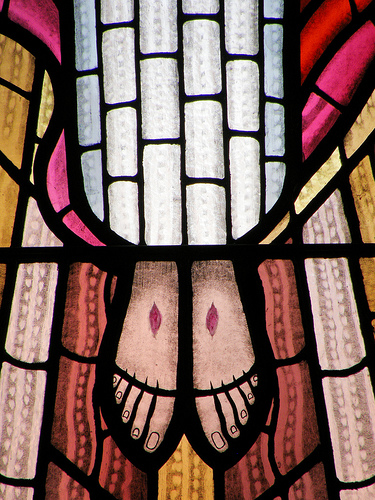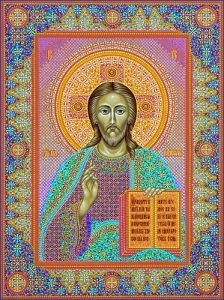Lectionary reflection, Christ the King Sunday, Year C
November 20, 2022*
Then Jesus said, “Father, forgive them; for they do not know what they are doing.” Luke 23:34
The words of Jesus in verse 34 of this week’s gospel lesson haunt me. While Luke recounts these words in a particular place (Golgatha) and at a particular hour (Jesus’ crucifixion), they echo across time and space, consistently drawing me–all of us–back to the foot of that same cross and at the same feet of the crucified and risen King of Kings.
Now falling at the feet of a king is not an unusual posture for loyal subjects. Historically, that is exactly the sort of behavior people exhibit in the presence of royalty. Maybe such bowing and scraping is motivated by fear; perhaps it stems from a sense of respect and some element of awe. It might even be the by-product mostly of tradition and expectation. The king, however, is found seated above his subjects, resplendent on a golden throne, bedecked in fine fabrics and dripping with fine metals and precious jewels. The king of lore and history is a monarch of imposing presence, a majestic ruler surrounded by courtiers, servants, and soldiers.
Falling at the feet of Christ the King is a considerably different encounter. Our king’s feet are dirty and bloody, his body broken and beaten, his head bowed beneath the sting of a crown of woody thorns. No jewels, no robes of finest linen, no signet ring or sword. Brutally executed in a manner befitting only the worst criminals and political insurrectionists, the King of Kings commands that we confront the darkest corners of the human condition. His eyes see deeply into one’s very soul, exposing all the secrets, shame, and hurts. Because he has plunged to the very depth of human despair and suffering, there is nothing he does not know or understand.
Christ is the King of Kings, the ruler who turns all of our human notions and illusions of power squarely on their heads. In what by worldly definitions appears to be weakness and failure, Jesus shows that real power is rooted in love, bathed in grace, and covered with mercy. He is the one who redeems that which seems unredeemable and the one who loves those who appear unlovable. By his broken body, bruises, and lacerations, we are healed and restored to wholeness. The slate is wiped clean and we are made new. Now that’s real power!
Yes, the king imagery is quite a stretch in our modern day Western culture. It just doesn’t resonate with our democratic, individualistic, bootstraps culture. But Jesus’ words of absolution and his promise to that humbled and broken criminal beside him cut through all cultural filters and barriers. They touch the very deep place of need within each human heart. In Christ we are forgiven AND we belong. This is what matters. This is what’s real. Jesus Christ is truly a king like no other: Born into this life a homeless babe of a peasant mother, lived as an alien in a foreign land, challenged the status quo as a radical rabbi, and crucified as a common criminal. From birth through death, and from resurrection to life eternal, Jesus is with us holding all things together.
Forgive us, Lord, for we still know not what we are doing. Thank you for your gracious promise of life. Thank you for loving us in spite of ourselves. This is indeed good news for all people.
In Worship
Consider focusing on Luke 23:34. What are we doing today that might cause Jesus to pray these words on our behalf? What are we not doing? What corporate acts of commission or omission might need forgiveness? We usually come to the foot of the cross in Lent, but maybe Christ the King Sunday is another time that we need to bow at the feet of our Lord. In what ways, by what images, and through what actions might you help people connect to the idea of Christ’s countercultural and radical power?
With Youth
Cosmic Christ, Quantum Physics, and Holy Imagination
This week’s epistle passage from Colossians is a great way to launch a conversation about how faith and science connect. Use Eugene Peterson’s version of this lesson from The Message. If you happen to have a parishioner well-versed in Quantum Physics, invite him or her to take part in the discussion. How does the notion that “…all the broken and dislocated pieces of the universe–people and things, animals and atoms–get properly fixed and fit together in vibrant harmonies…” This discussion may yield some questions not easily answered, but it also provides an opportunity for wonder and awe. Want a music video to accompany this discussion? Consider “I Can Only Imagine” by Mercy Me.
With Children
Real Strength
Bring a couple of small barbells with you. Pull them out and begin doing curls or other arm-strengthening exercises. Talk to the children about the importance of weight-bearing exercise to strengthen bones and muscles. Read Colossians 1:11-12 to the children: “May you be made strong with all the strength that comes from his [Jesus’] glorious power, and may you be prepared to endure everything with patience, while joyfully giving thanks to the Father, who has enabled you to share in the inheritance of the saints in light.”
A Christian’s strength does not come from working out with weights–although it is good to take care of your body and health. A Christian’s strength comes from Jesus. We are strengthened by Jesus each and every day–when we pray, when we study God’s word, when we worship and share Christ’s meal, and when we practice our faith by what we say and do. Jesus strengthens not only our bodies, but also our minds, our hearts, and our spirits–all of us!
End with a prayer like this one: Dear Jesus, please help me to grow stronger in you. Help me to exercise my body, my heart, and my mind to serve you better and to love you more by loving my neighbors as myself. Thank you for loving me. Amen.
*This reflection was first published in 2013.
Photos: Sue Hasker, Waiting for the Word, and Nicholas Manuel, Creative Commons






Leave a Reply